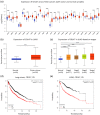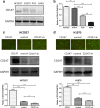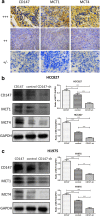Enhanced glucose metabolism mediated by CD147 is associated with 18 F-FDG PET/CT imaging in lung adenocarcinoma
- PMID: 32162491
- PMCID: PMC7180588
- DOI: 10.1111/1759-7714.13383
Enhanced glucose metabolism mediated by CD147 is associated with 18 F-FDG PET/CT imaging in lung adenocarcinoma
Abstract
Background: Lung adenocarcinoma (LUAD) is one of the most deadly thoracic tumors. Reprogrammed glycolytic metabolism is a hallmark of cancer cells and significantly affects several cellular functions. In the current study, we aimed to investigate cluster of differentiation 147 (CD147)-mediated glucose metabolic regulation in LUAD and its association with 18 F-FDG PET/CT imaging.
Methods: The expression profile and prognostic potential of CD147 in LUAD were analyzed using UALCAN and a Kaplan-Meier plotter. Tissue immunohistochemical analyses and PET metabolic parameters were used to identify the relationship between CD147 expression and reprogrammed glycolysis. The role of CD147 in glucose metabolic reprogramming was assessed by radioactive uptake of 18 F-FDG through γ-radioimmunoassays in vitro and micro-PET/CT imaging in vivo. Western blotting assays were used to determine the expression level of monocarboxylate transporter 1 (MCT1) and MCT4 in established human LUAD cell lines (ie, HCC827 and H1975) with different CD147 expression levels via lentiviral transduction.
Results: CD147 was highly expressed in LUAD. A significant positive correlation existed between CD147 expression and PET metabolic parameters(SUVmax,SUVmean, SUVpeak). CD147 could promote radioactive uptake of 18 F-FDG in vitro and in vivo, suggesting the ability of CD147 to enhance glycolytic metabolism. Furthermore, as an obligate chaperone for MCT1 and MCT4, CD147 positively correlated with MCT1 and MCT4 expression in LUAD tissues and established cell lines with different CD147 expression.
Conclusions: Our study revealed that CD147 is a promising novel target for LUAD treatment and CD147-mediated glucose metabolism demonstrated its contribution to the predictive role of 18 F-FDG PET/CT imaging for targeted therapeutic efficacy.
Keywords: 18F-FDG PET/CT imaging; CD147; glucose metabolism; lung adenocarcinoma.
© 2020 The Authors. Thoracic Cancer published by China Lung Oncology Group and John Wiley & Sons Australia, Ltd.
Figures

 low,
low,  high. (e) Kaplan‐Meier survival curves comparing the high and low expression of CD147 in LUAD (n = 720) which indicated that OS was significantly higher in the CD147 low expression group than in the high expression group (***P < 0.001). Expression
high. (e) Kaplan‐Meier survival curves comparing the high and low expression of CD147 in LUAD (n = 720) which indicated that OS was significantly higher in the CD147 low expression group than in the high expression group (***P < 0.001). Expression  low,
low,  high.
high.


 CD147,
CD147,  control,
control,  CD147‐sh (c) Representative micro‐PET/CT images of HCC827‐CD147, HCC827‐control, and HCC827‐CD147‐sh xenografts. Nude mice injected with lentiviral transduced HCC827 cell lines with different status of CD147 expression. 18F‐FDG micro‐PET/CT imaging was performed to determine the influence of CD147 on glucose uptake in vivo. The tumors were clearly visible, and more 18F‐FDG accumulation was observed in HCC827‐CD147 xenografts than in HCC827‐control and HCC827‐CD147‐sh xenografts. (d) Histograms were drawn to identify the differences existed in SUVmax for xenografts developed from lentiviral transduced HCC827 cell lines with different status of CD147 expression. As shown, the SUVmax was dramatically higher in HCC827‐CD147 xenografts than in HCC827‐control and HCC827‐CD147‐sh xenografts. Compared to the HCC827‐control xenografts, SUVmax was significantly decreased in the HCC827‐CD147‐sh xenografts. (***P < 0.001).
CD147‐sh (c) Representative micro‐PET/CT images of HCC827‐CD147, HCC827‐control, and HCC827‐CD147‐sh xenografts. Nude mice injected with lentiviral transduced HCC827 cell lines with different status of CD147 expression. 18F‐FDG micro‐PET/CT imaging was performed to determine the influence of CD147 on glucose uptake in vivo. The tumors were clearly visible, and more 18F‐FDG accumulation was observed in HCC827‐CD147 xenografts than in HCC827‐control and HCC827‐CD147‐sh xenografts. (d) Histograms were drawn to identify the differences existed in SUVmax for xenografts developed from lentiviral transduced HCC827 cell lines with different status of CD147 expression. As shown, the SUVmax was dramatically higher in HCC827‐CD147 xenografts than in HCC827‐control and HCC827‐CD147‐sh xenografts. Compared to the HCC827‐control xenografts, SUVmax was significantly decreased in the HCC827‐CD147‐sh xenografts. (***P < 0.001).
References
-
- Siegel RL, Miller KD, Jemal A. Cancer statistics, 2019. CA Cancer J Clin 2019; 69: 7–34. - PubMed
-
- Gridelli C, Rossi A, Carbone DP et al Non‐small‐cell lung cancer. Nat Rev Dis Primers 2015; 1: 15009. - PubMed
-
- Hutchinson BD, Shroff GS, Truong MT, Ko JP. Spectrum of lung adenocarcinoma. Semin Ultrasound CT MR 2019; 40: 255–64. - PubMed
-
- Dolly SO, Collins DC, Sundar R, Popat S, Yap TA. Advances in the development of molecularly targeted agents in non‐small‐cell lung cancer. Drugs 2017; 77: 813–27. - PubMed
Publication types
MeSH terms
Substances
Grants and funding
LinkOut - more resources
Full Text Sources
Medical
Miscellaneous

